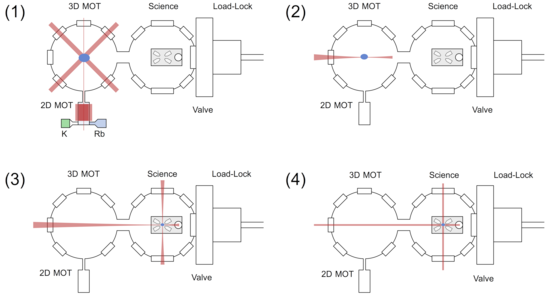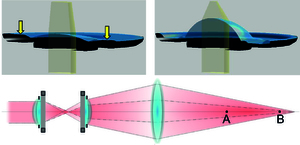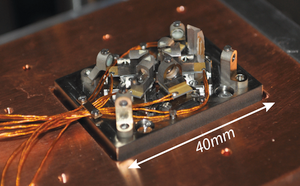Impact Lab
The ultra-high vacuum transfer system
Our vacuum system allows for the rapid exchange of a modular science platform, while maintaining a vacuum of 1x10-11mBar. This platform houses the cavity setups that we want to study and that we bring in close vicinity to a quantum gas. After inserting it into the science chamber, the platform slides into a fixed docking station, which provides passive vibration isolation, as well as microwave, electrical and thermal connections to the sledge. High positioning accuracy is guaranteed by a dovetail construction of the sliding mechanism.
Re-entrant windows along the vertical axis provide a good optical access for high-resolution imaging of the quantum gas. The imaging resolution can be improved even further by mounting a lens in vacuo on the science platform.
We start an exchange of the platform by baking the new setup in the load lock chamber. Once we achieve very good vacuum in the load lock, a gate valve is opened and the transfer takes place. The transfer rod is manipulated from outside the vacuum by strong magnets and can be decoupled from the science platform via a bajonet mechanism once it reached its final position. The video demonstrates the transfer of the platform from the load lock chamber into the science chamber, where it connects to the docking station.
Preparing a Bose-Einstein condensate
 The experimental sequence starts with a 3DMOT of 87Rb loaded from a 2DMOT (1). By working in the 2D+MOT configuration, which includes two beams along the axial direction, we achieve a high atomic flux of 5x109 atoms/s. Apart from a Rubidium reservoir, the 2DMOT chamber also includes a 40K source, which could be used at a later stage of the experiment. After sub-Doppler cooling to about 10 μK in an optical molasses, the atoms are loaded into a magnetic quadrupole trap where radio-frequency evaporation is performed in order to increase the phase-space density of the gas. Before spin-flip induced losses become detrimental, the atoms are transferred into a hybrid trap consisting of an optical dipole trap for radial confinement and a weak, levitating magnetic quadrupole field for axial confinement (2). We subsequently ramp down the magnetic confinement and optically transport the atoms to the science chamber with the cavity setup (3). At the science chamber, we switch on a crossed dipole beam and perform optical evaporation until we obtain a nearly pure Bose-Einstein condensate (4).
The experimental sequence starts with a 3DMOT of 87Rb loaded from a 2DMOT (1). By working in the 2D+MOT configuration, which includes two beams along the axial direction, we achieve a high atomic flux of 5x109 atoms/s. Apart from a Rubidium reservoir, the 2DMOT chamber also includes a 40K source, which could be used at a later stage of the experiment. After sub-Doppler cooling to about 10 μK in an optical molasses, the atoms are loaded into a magnetic quadrupole trap where radio-frequency evaporation is performed in order to increase the phase-space density of the gas. Before spin-flip induced losses become detrimental, the atoms are transferred into a hybrid trap consisting of an optical dipole trap for radial confinement and a weak, levitating magnetic quadrupole field for axial confinement (2). We subsequently ramp down the magnetic confinement and optically transport the atoms to the science chamber with the cavity setup (3). At the science chamber, we switch on a crossed dipole beam and perform optical evaporation until we obtain a nearly pure Bose-Einstein condensate (4).
Optical transport into the cavity setup using focus-tunable lenses
 The optical transport from the hybrid trap in the MOT chamber to the science platform is performed by displacing the focus of the dipole trap with focus-tuneable lenses over 28cm. The focal length of these lenses can be steered by an applied current. We have developed an optical setup that allows us to dynamically control both waist and focus position of the transport beam, thereby also allowing for trap compression. The fraction of atoms that are transported over the entire distance comes near to unity, while the heating of the cloud is in the range of a few microkelvin.
The optical transport from the hybrid trap in the MOT chamber to the science platform is performed by displacing the focus of the dipole trap with focus-tuneable lenses over 28cm. The focal length of these lenses can be steered by an applied current. We have developed an optical setup that allows us to dynamically control both waist and focus position of the transport beam, thereby also allowing for trap compression. The fraction of atoms that are transported over the entire distance comes near to unity, while the heating of the cloud is in the range of a few microkelvin.
Current science platform: a crossed cavity setup
 The system we currently study is a setup consisting of two cavities crossing under an angle of 60°. The cavity mirrors are machined with a mill in order to approach them as close as possible. We reach a mirror distance of about 2mm, resulting in an atom-light coupling comparable to the atomic decay. At the same time, a high Finesse ensures the cavity decay rate to be negligible compared to the coupling rate. The length of each cavity is stabilized with a weak laser beam at 830nm, which can be tuned independently from the probe beam at around 780nm.
Since our vacuum chamber does not offer optical access under 60°, we added four in- and out-coupling mirrors on the platform, which reflect the cavity beams to vacuum viewports. Furthermore, two prism-shaped protecting mirrors reflect the dipole beam off the cavities while transporting into the setup.
The science platform also contains an aspheric lens with a high numerical aperture of NA=0.55, which can be used for local imaging and probing of the quantum gas coupled to the cavities. An additional in vacuo mirror can be used to transversely pump the atomic cloud with a standing wave. It can be moved by means of a piezoelectric crystal to change the interference pattern arising from the three standing waves from triangular to hexagonal.
The system we currently study is a setup consisting of two cavities crossing under an angle of 60°. The cavity mirrors are machined with a mill in order to approach them as close as possible. We reach a mirror distance of about 2mm, resulting in an atom-light coupling comparable to the atomic decay. At the same time, a high Finesse ensures the cavity decay rate to be negligible compared to the coupling rate. The length of each cavity is stabilized with a weak laser beam at 830nm, which can be tuned independently from the probe beam at around 780nm.
Since our vacuum chamber does not offer optical access under 60°, we added four in- and out-coupling mirrors on the platform, which reflect the cavity beams to vacuum viewports. Furthermore, two prism-shaped protecting mirrors reflect the dipole beam off the cavities while transporting into the setup.
The science platform also contains an aspheric lens with a high numerical aperture of NA=0.55, which can be used for local imaging and probing of the quantum gas coupled to the cavities. An additional in vacuo mirror can be used to transversely pump the atomic cloud with a standing wave. It can be moved by means of a piezoelectric crystal to change the interference pattern arising from the three standing waves from triangular to hexagonal.
 The experimental sequence starts with a 3DMOT of 87Rb loaded from a 2DMOT (1). By working in the 2D+MOT configuration, which includes two beams along the axial direction, we achieve a high atomic flux of 5x109 atoms/s. Apart from a Rubidium reservoir, the 2DMOT chamber also includes a 40K source, which could be used at a later stage of the experiment. After sub-Doppler cooling to about 10 μK in an optical molasses, the atoms are loaded into a magnetic quadrupole trap where radio-frequency evaporation is performed in order to increase the phase-space density of the gas. Before spin-flip induced losses become detrimental, the atoms are transferred into a hybrid trap consisting of an optical dipole trap for radial confinement and a weak, levitating magnetic quadrupole field for axial confinement (2). We subsequently ramp down the magnetic confinement and optically transport the atoms to the science chamber with the cavity setup (3). At the science chamber, we switch on a crossed dipole beam and perform optical evaporation until we obtain a nearly pure Bose-Einstein condensate (4).
The experimental sequence starts with a 3DMOT of 87Rb loaded from a 2DMOT (1). By working in the 2D+MOT configuration, which includes two beams along the axial direction, we achieve a high atomic flux of 5x109 atoms/s. Apart from a Rubidium reservoir, the 2DMOT chamber also includes a 40K source, which could be used at a later stage of the experiment. After sub-Doppler cooling to about 10 μK in an optical molasses, the atoms are loaded into a magnetic quadrupole trap where radio-frequency evaporation is performed in order to increase the phase-space density of the gas. Before spin-flip induced losses become detrimental, the atoms are transferred into a hybrid trap consisting of an optical dipole trap for radial confinement and a weak, levitating magnetic quadrupole field for axial confinement (2). We subsequently ramp down the magnetic confinement and optically transport the atoms to the science chamber with the cavity setup (3). At the science chamber, we switch on a crossed dipole beam and perform optical evaporation until we obtain a nearly pure Bose-Einstein condensate (4). The optical transport from the hybrid trap in the MOT chamber to the science platform is performed by displacing the focus of the dipole trap with focus-tuneable lenses over 28cm. The focal length of these lenses can be steered by an applied current. We have developed an optical setup that allows us to dynamically control both waist and focus position of the transport beam, thereby also allowing for trap compression. The fraction of atoms that are transported over the entire distance comes near to unity, while the heating of the cloud is in the range of a few microkelvin.
The optical transport from the hybrid trap in the MOT chamber to the science platform is performed by displacing the focus of the dipole trap with focus-tuneable lenses over 28cm. The focal length of these lenses can be steered by an applied current. We have developed an optical setup that allows us to dynamically control both waist and focus position of the transport beam, thereby also allowing for trap compression. The fraction of atoms that are transported over the entire distance comes near to unity, while the heating of the cloud is in the range of a few microkelvin.
 The system we currently study is a setup consisting of two cavities crossing under an angle of 60°. The cavity mirrors are machined with a mill in order to approach them as close as possible. We reach a mirror distance of about 2mm, resulting in an atom-light coupling comparable to the atomic decay. At the same time, a high Finesse ensures the cavity decay rate to be negligible compared to the coupling rate. The length of each cavity is stabilized with a weak laser beam at 830nm, which can be tuned independently from the probe beam at around 780nm.
Since our vacuum chamber does not offer optical access under 60°, we added four in- and out-coupling mirrors on the platform, which reflect the cavity beams to vacuum viewports. Furthermore, two prism-shaped protecting mirrors reflect the dipole beam off the cavities while transporting into the setup.
The science platform also contains an aspheric lens with a high numerical aperture of NA=0.55, which can be used for local imaging and probing of the quantum gas coupled to the cavities. An additional in vacuo mirror can be used to transversely pump the atomic cloud with a standing wave. It can be moved by means of a piezoelectric crystal to change the interference pattern arising from the three standing waves from triangular to hexagonal.
The system we currently study is a setup consisting of two cavities crossing under an angle of 60°. The cavity mirrors are machined with a mill in order to approach them as close as possible. We reach a mirror distance of about 2mm, resulting in an atom-light coupling comparable to the atomic decay. At the same time, a high Finesse ensures the cavity decay rate to be negligible compared to the coupling rate. The length of each cavity is stabilized with a weak laser beam at 830nm, which can be tuned independently from the probe beam at around 780nm.
Since our vacuum chamber does not offer optical access under 60°, we added four in- and out-coupling mirrors on the platform, which reflect the cavity beams to vacuum viewports. Furthermore, two prism-shaped protecting mirrors reflect the dipole beam off the cavities while transporting into the setup.
The science platform also contains an aspheric lens with a high numerical aperture of NA=0.55, which can be used for local imaging and probing of the quantum gas coupled to the cavities. An additional in vacuo mirror can be used to transversely pump the atomic cloud with a standing wave. It can be moved by means of a piezoelectric crystal to change the interference pattern arising from the three standing waves from triangular to hexagonal.